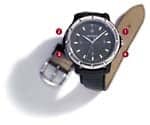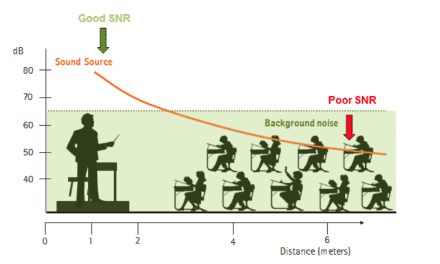The interference of background noise is the single greatest problem reported by hearing aid wearers.1 It is crucial that the effects of listening in background noise be taken into account not only when designing new hearing aids but also when dispensing modern hearing aids. Premium digital hearing aids should maximize speech intelligibility while providing excellent comfort in noise. This is not a new concept and has been the foundation of some of our hearing instruments and fitting rationales for years.
This article addresses three questions that are crucial to providing optimal speech understanding in noise, along with ensuring listening comfort:
- What are the features of a prescriptive rationale that will affect speech understanding?
- How do people with a hearing loss best perceive and understand speech in noise?
- How can we make listening more comfortable and natural when speech is not present?
Hence, speech should be our top priority and is where we should start in answering the questions raised.
Selecting the Best Rationale
While there are a number of different technologies (eg, directional microphones, speech enhancement algorithms, noise reduction strategies, etc) designed to maximize speech understanding in noise, the effect of the overall speech processing rationale that the hearing instrument utilizes needs to be understood. Recently, Schum & Pogash2 examined three different levels of technology which broadly represent the market today. Those being linear, Wide Dynamic Range Compression (WDRC), and a premium digital product (in this case, Adapto by Oticon). They reported statistically significant differences between all three levels of technology (Figure 1) in terms of speech understanding in quiet and in background noise. These results demonstrated that speech understanding, especially in challenging listening situations, can be improved first by the use of multi-channel, non-linear amplification and further by the advanced signal processing capabilities of modern digital hearing aids.

The advantages of non-linear signal processing over linear hearing instruments are fairly clear, but it is not so obvious why a premium product should provide significantly better speech perception in quiet and noise than a WDRC instrument in the absence of directional microphones. While Adapto does implement technology such as VoiceFinder and OpenEar Acoustics, which are designed to lessen listening fatigue, improve comfort, and maximize sound quality, these features do not necessarily lead to improved speech understanding.
Crucially, the hearing instrument implements Client Focused Fitting. Recent research by Gatehouse, Naylor & Elberling3 suggest that there is no single amplification strategy that is best for everybody. This is hardly surprising, as previous research demonstrates that people differ in preferences for gain, attack/release time, and compression ratio.4-7 Additionally, these preferences alter with changes in listening environment and user demands (ie, understanding or comfort).5-7
Gatehouse et al.3 built on this research by demonstrating that the incorporation of an auditory profile based on the user’s auditory ecology leads to improved selection of compression characteristics (eg, fast, slow, and/or linear). Therefore, dispensing professionals need to look beyond the audiogram and investigate the user’s auditory ecology. A more individualized fitting can be provided by employing a “Personal Profile” for each user. Client Focused Fitting should include information on the user’s previous amplification strategies, age, and the completion of a Personal Profile that helps examine the user’s listening environments and needs. This information, in addition to the client’s audiogram, then prescribes the rationale that yields the best probability for a successful fitting. Consequently, it’s likely that speech understanding with the advanced digital instrument was superior to WDRC in the Schum & Pogash2 study due to the combined effect of selecting the optimum gain and compression characteristics through Client Focused Fitting in addition to the natural sound provided by Open Ear Acoustics.
In other words, the first and most important aspect of maximizing speech understanding is to provide the listener with an optimal fitting rationale that ensures speech cues are being amplified appropriately. Based on the user’s auditory ecology, different people will show different performance when the compression characteristics of the hearing aid are altered. Therefore, the compression and gain characteristics of the hearing aid should be optimized for the client before additional technology designed to maximize speech understanding in noise is considered.
Using Directional Microphones to Improve SNR
The only proven method to improve speech understanding in noise is through the use of a directional microphone. Directional microphones work by suppressing the signal from the sides and/or rear of the wearer while retaining audibility for signals from the front. The underlying assumption is that users will be facing the person with whom they are talking and wish to perceive that signal in preference to other speakers or background noise.
Signal-to-noise ratio (SNR) improvement via directional microphones has been estimated at about 3-4 dB when speech and noise are presented in ways that are representative of real-world listening environments.8,9 This improvement has been found to be independent of the speech material, noise interference, audiogram slope, high frequency hearing loss, omnidirectional speech intelligibility performance, number of microphones or hearing aid circuit type.8,10,11
While directional microphones do provide improvements when listening to speech in noise, they are not necessarily the panacea to speech understanding in noise problems for all users all of the time. Recent research by Cord and colleagues12 examined listening performance by users in everyday life, rather than performance in the laboratory. They found that users frequently switched between an omni and directional microphone, and chose to use the directional microphone for only 25% of their listening situations. The choice of microphone was dependent on four factors:
- The relative location of the talker;
- The presence or absence of background noise;
- The type of noise, and
- The type of space in which the conversation occurs.13
Consequently, the demands of everyday listening lead users to switch between omni and directional programs and to the conclusion that the directional program does not always provide the best performance when listening to speech in noise. Therefore, it should be remembered that, while directional microphones remain the only method of improving speech understanding in noise, they are not the solution for every user in every situation.
Using DSP to Improve Speech Understanding in Noise
The other approach to maximizing speech understanding in noise is by using either a speech detection or a noise reduction strategy.
Noise reduction strategies are built around the concept of modulation-based noise reduction. They are activated on detection of modulation frequency and/or modulation depth of the input signal. In theory and in practice, these systems can detect frequency bands where noise dominates over speech and suppress amplification of these bands. It is important to note that this approach never changes the SNR in any frequency region. It only changes the relative frequency response, maximizing amplification in regions with better SNRs and reducing amplification in regions with poorer SNRs. These systems in the laboratory and in the clinic provide improved listening comfort but rarely improve speech intelligibility; the problem is that they are very sensitive to background noise and therefore tend to reduce the gain even at relatively favorable signal to noise levels.
Similarly, the benefit of employing many discrete independent bands may be limited, because the background noise experienced in everyday listening environments is predominantly broadband. To the author’s knowledge, none of the available noise reduction systems can suppress noise without simultaneously suppressing speech cues as well. In some cases, this reduction of gain may actually lead to reduced speech understanding in noise (Figure 2). Given that all people with hearing impairments have reduced speech understanding in noise due to the effects of masking of the speech signal and decreased dynamic range, it can be counter-productive to reduce their speech understanding further under the premise of an “intelligent noise reduction” system.

Noise reduction systems, therefore, do not make speech easier to understand, but do make listening less fatiguing and more comfortable.14 The logical conclusion of noise reduction strategies is to decrease amplification when speech is not present rather than to attempt to separate speech from noise which is often broadband and speech shaped.14,15
Given the above, a better approach might be to focus on maximizing speech understanding in noise rather than focusing primarily on comfort. Studies examining speech intelligibility in noise have found that, when listening in noise, users seeking greater speech intelligibility will increase the gain (ie, turn up the volume control) by approximately 3-5 dB to maintain clarity.16,17 Conversely, when asked to maintain comfort, users will often decrease the gain of the hearing instrument,17 as is the case with noise reduction systems. Therefore, noise reduction strategies, by decreasing the gain of the hearing aid when in noise, do improve comfort but also run the risk of decreasing speech intelligibility. This is consistent with research by Barker & Dillon18 who found that comfort may be rated by listeners as more important than speech intelligibility in high levels of noise. Consequently, the level of background noise affects the preferred listening level of the hearing-impaired user.19
It is important to note that these previous studies of preferred volume control setting were implemented in simpler, single-channel circuitry. Modern noise reduction approaches have almost exclusively been implemented in fully automatic, multi-channel non-linear hearing aids. As part of the fitting rationale and follow-up fine-tuning, the non-linear circuitry should be set to provide acceptability in louder background noise environments. Therefore, if the core circuitry of the device is set appropriately, the patient should not be forced to choose between comfort and speech understanding.
If noise reduction is being used to avoid discomfort in louder listening situations, then more attention should be applied first to obtaining the optimum gain and compression settings. Even if the response of the hearing aid is acceptably comfortable in louder environments, the patient may still prefer to have gain reductions applied when it is not essential to hear everything that is being said. The goal of such a technique would be to decrease the overall “dose” of sound, decreasing long-term annoyance.
Therefore, a second logical alternative implementation of signal processing in noise is to maintain the gain when speech is present, but to decrease the gain (and increase release times and compression ratios) when speech is not present.
Ensuring Comfort in Noise While Retaining Speech Clarity
Clearly, the best solution is to maintain the gain of the hearing instrument, but this runs the risk of decreasing long-term user acceptance due to comfort issues. Users of modern digital instruments expect solutions to the problem of understanding speech in noise. Instead of focusing on noise, a better solution appears to be to focus on speech. This involves maximizing clarity when speech is present and ensuring long-term acceptance when speech is not present.
Speech detectors, such as Synchro,14 have been designed to accurately detect when speech is present, then provide maximum intelligibility of the speech signal; alternatively, they are designed to detect when speech is absent, then provide a comfortable listening experience—irrespective of the degree of background noise. Implementation of this system within VoiceFinder allows the hearing aid to automatically switch between the two modes: one that maximizes speech perception and a second that maximizes comfort. Importantly, the transition times between the two modes are configured so that the hearing aid quickly changes from “comfort” to “speech” mode (<900 ms) but changes more slowly (7-10 ms) when moving from “speech” to “comfort” mode. This ensures that, whenever speech is present, the hearing aid quickly shifts into speech mode and slowly settles into comfort mode when speech is absent.
In terms of comfort, the first aspect that needs to be altered is the gain of the hearing instrument. The gain should be reduced to a comfortable level but not turned off. By increasing the compression ratio, the gain can be reduced for loud inputs but maintained for softer inputs. By maintaining gain for soft inputs, the user remains connected to the outside world. There also needs to be an activation delay where the gain decreases if the hearing aid changes from one mode to the other preventing the instrument from sounding “choppy.”
Often overlooked is the issue of release time and comfort. People prefer a short release time when listening to speech, but a longer release time in noise. Increases in release time lead to increases in ratings of clarity, pleasantness, overall impression, and a decrease in background noise.20 Neuman & colleagues4 found that sound quality judgements were differently affected by background noise, and that longer release times led to a perception of reduced background noise levels. Consequently, by increasing the compression and release time of the instrument in Comfort Mode when speech is absent, the perception of comfort in noise can be increased.
In theory, users may benefit from a system that provides full audibility when speech is present and comfort when speech is not. However, two questions should be asked:
- Does this system work for perception of speech in noise?
- Do users actually prefer such a system?
The study by Dean & McDermott19 examined speech perception in noise. During the gaps between speech, they simulated a hearing instrument that attenuated the gain when speech was not present. They found that users were able to choose a setting which maximized intelligibility without being uncomfortable, despite the presence of background noise. Hence, hearing instruments that detect speech—rather than noise—and reduce the gain (and increase release times) in the periods when comfort is more important enable the user to maintain the gain setting of the hearing aid without having to sacrifice comfort.
Second, in a blind study by Schum & Pogash,2 77 participants were asked to evaluate three sets of technology—linear, WDRC and advanced digital. The advanced digital system was the preferred solution for understanding speech in noise, sound quality, and all-day listening experience (Figure 3). It is the combination of a speech enhancing prescription along with an approach whereby comfort is promoted when speech is not present that provides the optimum solution for listening throughout the day.

The final advantage of a speech detection system may be in the speech detection itself. The listener is provided with a cue that speech is present by the response of the hearing aid. This ramp-up of sound in itself can act as an alerting device to further enhance the listening comfort and reduce the listening fatigue of the user.
Conclusion
The first and most important aspect to maximizing speech understanding in noise is to provide the optimum hearing instrument prescription for the user. Different people have different auditory histories and live in different auditory ecologies. Therefore, the optimum rationale is one that matches the gain and compression characteristics to the user’s personal profile. For many users, the provision of a directional microphone will further enhance speech understanding in noise. It should be remembered, however, that directional microphones are not the optimum solution for every speech in noise listening situation. To provide the best degree of comfort, noise-reduction systems should go to their logical next step and provide a speech-based rationale when speech is present, and a comfort-based rationale and comfort when speech is not present to decrease the listening day-long fatigue. Through the provision of personally selected speech-enhancing rationales, directional microphones, and other advanced systems, we can open up new possibilities for speech understanding and listening comfort in noise.
| This article was submitted to HR by Mark C. Flynn, PhD, the senior clinical audiologist at Oticon A/S, Hellerup, Denmark. Correspondence can be addressed to HR or Mark C. Flynn, PhD, Oticon A/S, Strandvejen 58, Hellerup, DK 2900, Denmark; email: email: [email protected]. |
References
1. Dillon H. Hearing Aids. New York: Thieme; 2001.
2. Schum DJ, Pogash RR. Blinded comparison of three levels of hearing aid technology. Hearing Review. 2003;10(1):40-43,64.
3. Gatehouse S, Naylor G, Elberling C. Benefits from hearing aids in relation to the interaction between the user and the environment. Intl Jour Audiol. In press.
4. Neuman AC, Bakke MH, Mackersie C, Hellman S, Levitt H. Effect of release time in compression hearing aids: Paired-comparison judgments of quality. J Acoust Soc Amer. 1995;98:3182-7.
5. Keidser G. The relationship between listening conditions and alternative amplification schemes for multiple memory hearing aids. Ear & Hear. 1995;16:575-586.
6. Byrne D. Hearing aid selection for the 1990s: Where to? J Amer Acad Audiol. 1996;7:377-395.
7. van Toor T, Verschuure H. Effects of high frequency emphasis and compression time constants on speech intelligibility in noise. Intl Jour of Audiol. 2002;41:379-394.
8. Wouters J, Litiere L, van Wieringen A. Speech intelligibility in noisy environments with one- and two-microphone hearing aids. Audiology. 1999;38:91-8.
9. Amlani AM. Efficacy of directional microphone hearing aids: a meta-analytic perspective. J Amer Acad Audiol. 2001;12:202-14.
10. Ricketts T, Dhar S. Comparison of performance across three directional hearing aids. J Amer Acad Audiol. 1999;10:180-9.
11. Ricketts T, Mueller HG. Predicting directional hearing aid benefit for individual listeners. J Amer Acad Audiol. 2000;11:561-9; quiz 575.
12. Cord MT, Surr RK, Walden BE, Olson L. Performance of directional microphone hearing aids in everyday life. J Amer Acad Audiol. 2002;13:295-307.
13. Surr RK, Walden BE, Cord M, Olsen J. Influence of environmental factors on hearing aid microphone preference. J Amer Acad Audiol. 2002;13:308-322.
14. Elberling C. About the VoiceFinder. News From Oticon: Audiological Research Documentation. 2002;3:1-11.
15. Dillon H. What do hearing aids do other than amplify sound? Audiology Now. 2002; 10:9-12.
16. Souza PE, Kitch VJ. Effect of preferred volume setting on speech audibility in different hearing aid circuits. J Am Acad Audiol. 2001;12:415-22.
17. Hochberg I. Most comfortable listening for the loudness and intelligibility of speech. Audiology. 1975;14:27-33.
18. Barker C, Dillon H. Client preferences for compression threshold in single-channel wide dynamic range compression hearing aids. Ear & Hear. 1999;20:127-39.
19. Dean MR, McDermott HJ. Preferred listening levels: The effect of background noise for moderately-to-profoundly hearing impaired aid users. Scand Audiol. 2000; 29:139-149.
20. Neuman AC, Bakke MH, Mackersie C, Hellman S, Levitt H. The effect of compression ratio and release time on the categorical rating of sound quality. J Acoust Soc Amer. 1998;103:2273-2281.





